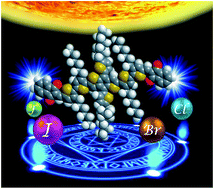Strategic end-halogenation of π-conjugated small molecules enabling fine morphological control and enhanced performance of organic solar cells†
Abstract
Organic solar cells based on π-conjugated small molecules (SM-OSCs) have developed rapidly in the past few years. Nevertheless, the design strategies of small-molecule (SM) donors for high-efficiency SM-OSCs require further improvement. Halogenation is an effective way to modulate their electronic properties, and to date, fluorination has been most widely used for the design of organic photovoltaic materials. However, the feasibility and utility of photovoltaic materials incorporating other halogens, especially heavier bromine and iodine, have not been fully explored. Here, a novel family of SM donor materials, having the same π-conjugated backbone but different terminal halogen groups (F, Cl, Br, and I), are systematically designed and developed. Furthermore, the structure–property–function relationships stemming from the variations in the substituted halogen atoms are discussed. Among these end-halogenated SM donors, the I-containing material shows remarkably high photovoltaic performance in the fullerene-based SM-OSCs, demonstrating power conversion efficiencies of up to 9.2% without any processing additives and post-treatment processes. Detailed morphological analyses reveal that end-halogenation with heavier halogen atoms, typified by I and Br, effectively modulated the interfacial free energy of the blend with a fullerene acceptor and facilitate the formation of fine interpenetrating networks in the active layer. This study establishes a new design paradigm featuring end-halogenation for producing high-performance photovoltaic materials for SM-OSCs.



 Please wait while we load your content...
Please wait while we load your content...